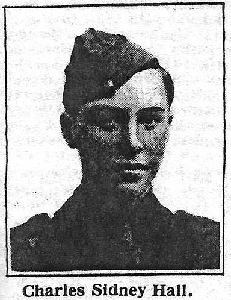
De Ruvigny Roll of Honour Vol. 3 page 125
Flight Magazine entry for Hall 18/06/1917
CWGC Headstone
60th Squadron preparing to take off April 1916
Sunderland Echo Saturday 11/08/1917
Charles Sidney Hall was born 9th April 1898, at Ashington, Northumberland, the third son of Joseph John Hall, a Mining Engineer, and his wife Emily Eleanor 'Nellie' of 'Westfield', Ashington, daughter of Thomas Lewis.
Charles was educated at the North Eastern County School at Barnard Castle, then Armstrong College, part of the University of Durham. He was studying to be in the same industry as his father, and wanted to be a Mining Engineer, with the intention of succeeding his father. Reported to be an outstanding swimmer.
Charles was a member of the O.T.C., both at school and at college. He also held a Honorary Instructor's Certificate, and a Medallion for the Royal Life Saving Society.
Charles’s eldest brother, Captain Lewis Wigham Hall, 1st Border Regiment and RFC, had served in an operational squadron at the front for a year before becoming a flying instructor. His other brother had been in France for two years with the Royal Engineers (50th Division) before being taken prisoner by the Germans on 27 May 1918.
He was gazetted a 2nd Lieutenant in the Royal Flying Corps on the 28th June 1916 just a few weeks after his eighteenth birthday.
He was in the 60th Squadron R.F.C., A pilot of some promise, the squadron history mentions his good work he was doing during March and April. and was killed in aerial combat in front of Arras on the 7th April 1917.
"A patrol of Nieuports from No 60 Sqn left Filescamp Farm aerodrome on an Offensive Patrol at 16:40, and fought 4 Albatros D.IIIs from Jasta 11 north of Mercatel at 17:45. The fight drifted to the British side of the lines before two Nieuports were shot down."
A6766, 2Lt C S Hall, was credited to Ltn Kurt Schäfer or Ltn Kurt Wolff.
Source: Australian Society of WW1 Aero Historians
He was buried 1000 yards south east of Tilloy-les-Mofflaines, east of Arras.
His Squadron Commander wrote:- "He was leading a fighting patrol of six machines on the evening of the 7th. [his was a Nieuport 23 A6766]. They most gallantly attacked a formation of hostile aeroplanes of much superior number, and two mchines were brought down. They got at least one Hun. Of the four who returned, three were very badly shot about.
Both our machines were observed to land behind the lines quite close up to the German Line. One hopes they are unhurt. We all liked your son immensely and miss him sorely."
His body was found by an officer of the R.F.A., in the subsequent advance of the British two days later. His eldest brother, Captain L. W. Hall, R.F.C., and 1st Battalion, The Border Regiment was flying continuously at the front for over twelve months, and was subsequently appointed Fling Instructor in the latest British aeroplanes and his other brother, who also volunteered at the beginning of the was, has now [1918] been serving at the front line over two years with the Royal Engineers. in the 50th Division, but was captured by the Germans in the great attack on May 27th May. He was unmarried.
De Ruvigny Roll of Honour
An extract from the 60th Squadron History reads:
"Our Corps machines, the eyes of the artillery, were being shot down every day in the valley of the Scarpe, despite our efforts and those of 29 (also with Nieuports) and 11 [Squadron], an F.E.2B Squadron. The ground on both sides of the river was littered with B.E's. The scouts, whose losses were much heavier, fell usually far over the lines in hostile territory.
The work at this time still consisted mainly of offensive patrols (whose business it was to operate east of the artillery machines and to keep the air clear of hostile scouts), reconnaissance, and sometimes escorts to bombing and photographic patrols."
"On April 7th M. B. Knowles, C. S. Hall, and G. O, Smart -the latter was originally an N.C.O. pilot who had but lately been commissioned for gallantry in the field - all failed to return after an engagement with a much superior force of the enemy."
Source: The Northerner, Vol. XVII, no. 2, April 1918, page 2. (Acknowledgements to Tony Harding)
Second-Lieutenant, R.F.C., who was only 18 years of age, was killed in an air fight at the Front on April 7th. He was the son of Mr. J.J. Hall, of Westfield, Ashington, and was educated at the North Eastern County School, Barnard Castle, and Armstrong College, University of Durham, where he was preparing for the profession of a mining engineer. He was a member of the O.T.C. both at School and at University, and held an honorary instructor’s certificate and the medallion of the Royal Life Saving Society.
A brief biography of Lieut. Charles Sidney Hall with photograph is given in "Under the guns of the Kaiser's Aces" Franks, Norman; Giblin, Hal, Publisher: Grub Street, 2003. ISBN 10: 1904010024ISBN 1904010024.
Charles Sidney Hall is remembered at Ashington on A17.01 (A17.27) A17.43, at Barnard Castle on B135.20 in Newcastle on NUT063 and in Durham on D47.151.
The Canadian Virtual War Memorial page 577
Armstrong College Digital ROH book
The CWGC entry for 2nd Lieutenant Hall

